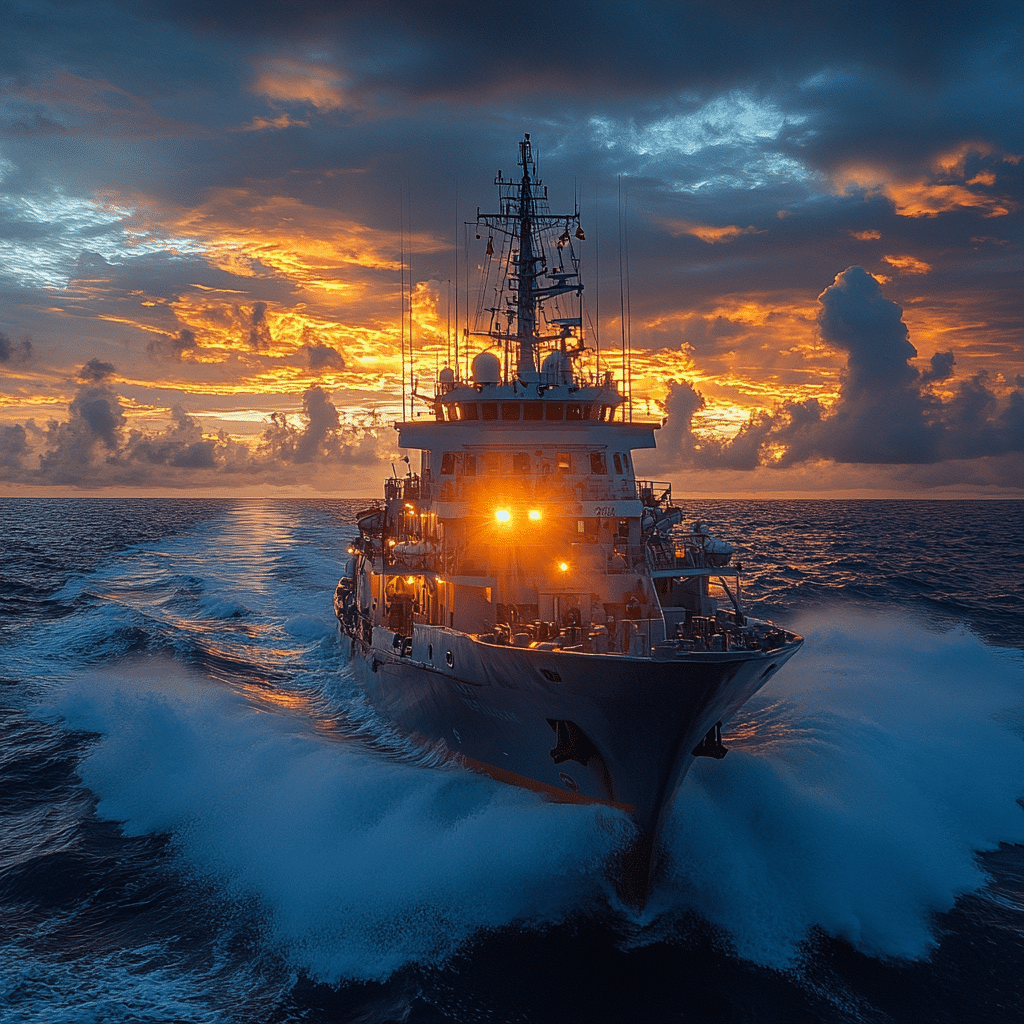The Philippine Coast Guard (PCG) stands as the vigilant guardian of maritime safety in one of the world’s largest archipelagos. With over 7,000 islands amidst vast ocean expanses, the Philippine Coast Guard is tasked with ensuring security not only for vessels navigating these waters but also for the lives that depend on them. Its responsibilities range from search and rescue operations to enforcing maritime law, all while contending with growing threats like climate change and illegal fishing. As we sail deeper into 2024, let’s explore the comprehensive framework that allows the PCG to perform its duties, the strategic initiatives it employs, and the leadership at its helm.
The Philippine Coast Guard’s Framework for Maritime Safety
The Philippine Coast Guard operates under a structured framework designed to meet the unique demands of maritime safety. This includes conducting regular search and rescue missions and enforcing laws critical for protecting both the marine environment and human lives. With natural disasters like typhoons becoming increasingly frequent and maritime traffic congesting due to commercial shipping, the PCG has significantly expanded its operational scope.
One of the core functions of the Philippine Coast Guard includes rigorous search and rescue operations. They are the first responders when disaster strikes, embodying the spirit of courage and altruism. During Typhoon Rai in December 2021, they mobilized swift rescue efforts to save stranded fishermen in Eastern Visayas. Their operations are not only a testament to their preparedness but also reflect their commitment to safeguarding lives at sea.
Additionally, the PCG plays a vital role in maritime law enforcement. From enforcing regulations against illegal fishing to preventing pollution in Philippine waters, each action aims to maintain the sustainability of marine resources. For example, targeted efforts against illegal dynamite fishing have significantly curbed depletion of local fish stocks, displaying a strong commitment to the health of marine ecosystems. By mastering these heightened responsibilities, the Philippine Coast Guard not only upholds maritime safety but actively contributes to environmental protection.

Top 5 Ways the Philippine Coast Guard Enhances Maritime Safety
The PCG adopts various strategies to strengthen maritime safety. Here are the top five initiatives making a tangible impact:
Whether faced with typhoons or maritime accidents, the Philippine Coast Guard executes search and rescue missions with incredible efficiency. Their mobilization during Typhoon Rai is a prime example. Equipped with boats, helicopters, and local intelligence, they save lives with urgency and expertise.
The task of enforcing maritime laws falls squarely on the shoulders of the PCG. Their crackdown on illegal fishing practices, like dynamite fishing, shows their unwavering commitment to sustainable fisheries. These efforts are bolstered by rigorous monitoring and collaboration with local fishing communities.
By partnering with international agencies, including training exercises with the Russian Navy, the PCG has enhanced its capabilities in maritime security. These relationships not only improve logistical integration but foster new tactical approaches to mitigate threats like piracy and contraband smuggling.
Raising awareness is crucial for maritime safety. The PCG’s educational campaigns reach out to local fishermen and maritime operators, teaching them essential safety measures, such as life jacket usage and navigation practices. By emphasizing the importance of these skills, they empower communities to act responsibly at sea.
Diving into the digital era, the Philippine Coast Guard has started employing innovative technologies such as drone monitoring and satellite tracking systems. This leap in surveillance capabilities means they can respond more quickly and effectively to incidents, enhancing their operational efficiency.
Leadership Dynamics: The Role of Chief Officers in the Philippine Coast Guard
Leadership in the Philippine Coast Guard plays a pivotal role in driving operations forward. The positions of the Chief Business Officer and Chief Commercial Officer are vital in ensuring the organization runs smoothly and effectively.
Through effective leadership, these officers make waves that support the PCG’s mission while tackling modern challenges in maritime safety.

Distinctive Symbols and Their Importance: The Maltese Cross Legacy
One glance at a PCG uniform or vessel reveals the iconic Maltese Cross, a symbol deeply rooted in maritime rescue and safety. This insignia not only represents courage but also unifies personnel under a shared commitment to service.
The Maltese Cross has an illustrious legacy intertwined with the values of bravery and compassion in the face of danger. It reinforces a strong sense of identity among Coast Guard personnel, serving as a daily reminder of the important work they undertake. Each time they don this emblem, they are reminded of their role as protectors of life at sea, ready to confront challenges head-on.
Emphasizing the significance of this symbol fosters camaraderie and motivates the staff to excel in their demanding roles. It symbolizes the ethos that binds the Philippine Coast Guard together, setting the tone for their unwavering dedication to maritime safety.
Challenges Ahead: Navigating a Complex Maritime Landscape
Amidst their admirable achievements, the Philippine Coast Guard still faces a myriad of challenges. The realities of climate change create turbulent conditions for maritime safety, while increasing illegal fishing activities threaten the sustainability of local fisheries.
With the frequency of typhoons on the rise, the PCG’s need for comprehensive strategic planning grows ever urgent. Each storm presents new risks, and allocating resources is a pressing concern. The Philippine Coast Guard acknowledges the looming threats and continues to prepare for them through adaptive strategies and enhanced operational training.
Moreover, economic pressures on coastal communities can lead to more desperate measures. As livelihoods are threatened, the PCG anticipates a potential increase in illegal fishing activities. The need for collaboration with local fishermen becomes vital, as does the continuous effort to promote legal fishing practices that safeguard resources.
The Path Forward: Strengthening the Future of Maritime Safety
As we transition into 2024, the Philippine Coast Guard is more than just a maritime law enforcement agency; it’s a beacon of hope and safety. Continuous improvements in training, innovative technology, and international collaboration are essential for facing an uncertain future.
With a focus on proactive rather than reactive responses, the PCG is intent on fortifying maritime safety measures. Recognizing that tomorrow’s challenges may demand novel approaches, they are prepared to adapt and innovate accordingly.
Through its combination of strategic leadership, public awareness a, advanced technology, and international partnerships, the Philippine Coast Guard envisions not just responding to emergencies but being a standard-bearer for maritime safety across Southeast Asia. The waves of tomorrow may be unpredictable, but with their dedication and resourcefulness, the PCG’s mission to protect lives at sea remains unwavering.
Anchoring their efforts in perseverance and innovation, the Philippine Coast Guard is steadfast on its course, providing a reassuring presence for all who venture onto the open seas.
The Philippine Coast Guard’s Vital Role in Maritime Safety
Fun Trivia about the Philippine Coast Guard
Did you know that the Philippine Coast Guard (PCG) is over a hundred years old? Established in 1901, this vital organization began as a small group, but it has evolved into a full-fledged service dedicated to ensuring maritime safety. They’re akin to skilled lifeguards, but for the vast Philippine archipelago, which is made up of more than 7,600 islands. Speaking of islands, the PCG’s efforts are crucial in protecting the rich biodiversity found in places like Tubbataha Reefs, a UNESCO World Heritage site admired by eco-tourists and scientists alike. Just imagine how many people could lose out on such wonders without the Coast Guard keeping watch over these precious waters!
Now, shifting gears a bit, let’s dive into an interesting fact. The Coast Guard plays a pivotal role during natural disasters, often collaborating with organizations to provide sanctuary and transport. For instance, when Typhoon Haiyan struck in 2013, the PCG was instrumental in rescue efforts, saving countless lives and ensuring safety on the seas and coastlines. Such actions are vital, especially with the unmistakable climate challenges we face today—kinda makes you appreciate why the PCG is so essential! No matter what the challenge, the bravery shown by these men and women serves as a beacon of hope, much like the star athletes we cheer for, like those we see at the World Cup.
The Operations of the Philippine Coast Guard
The Philippine Coast Guard isn’t just about rescue missions; they’re also heavily involved in enforcing maritime laws, preventing smuggling, and protecting fisheries. That’s right! They patrol our waters diligently, making sure everyone plays by the rules and doesn’t take more than their share. It’s not too far off from how athletes like Brendan Fletcher strive for excellence on the field—consistency and dedication make for winning results! Furthermore, did you know that their operations often cover the vast ocean stretches similar to how the Oregon Ducks football Vs Purdue boilermakers football match player Stats are tallied? Every detail counts in these rivalries, just as each patrol and operation contributes to overall maritime safety.
Want to hear something particularly cool? The PCG boasts a diverse fleet, including highly specialized vessels and even a few air assets. These resources allow them to respond swiftly to maritime emergencies, and their rapid deployment capabilities mean they’re always ready to engage wherever trouble arises, much like how fans eagerly jump back into discussions about their favorites, be it in sports or popular films like the oddly captivating Russian Lolita. Stability and readiness are critical, and the Coast Guard embodies these traits daily, offering peace of mind to all who traverse our beautiful waters.
In essence, the Philippine Coast Guard is an essential part of maritime safety, fiercely guarding our seas, aiding disaster response, enforcing laws, and keeping our ecosystem intact. So whether you’re enjoying a day at the beach or a thrilling match, remember the sturdy spirit behind the scenes—these heroes form the backbone of maritime order!

Is the Philippine Coast Guard a military?
The Philippine Coast Guard is not classified as a military force; it’s actually a uniformed service under the Department of Transportation, focusing on maritime law enforcement and safety.
How much is the salary of a Coast Guard in the Philippines?
Salaries for Coast Guard personnel in the Philippines can vary based on rank and experience, starting at around PHP 24,000 for entry-level positions and going up significantly for higher ranks.
What is the use of Philippine Coast Guard?
The Philippine Coast Guard’s main job is to enforce laws in Philippine waters, conduct maritime security operations, and protect lives and property at sea, responding to emergencies and ensuring safety.
What is the function of a Coast Guard?
A Coast Guard’s functions include enforcing maritime laws, conducting search and rescue operations, aiding vessels in distress, and helping prevent illegal activities like smuggling and poaching in national waters.
Why is the Coast Guard not considered military?
The Coast Guard isn’t considered military because it operates under a different department and primarily focuses on maritime safety and law enforcement rather than engaging in combat.
What is the highest rank in the Coast Guard?
The highest rank in the Philippine Coast Guard is admiral, which is typically achieved by the chief of the Coast Guard.
What are the benefits of joining the Philippine Coast Guard?
Joining the Philippine Coast Guard comes with benefits like job security, health insurance, retirement plans, and various allowances, plus the chance to serve the community and country.
What is the age limit for the Coast Guard?
The age limit for joining the Philippine Coast Guard usually caps at 26 years old for new recruits, although certain considerations might apply for prior military service.
How much do Filipino sailors make?
Filipino sailors’ salaries can vary widely based on their experience, the type of vessel, and the shipping company they work for, but wages can range from PHP 25,000 to PHP 100,000 or more monthly for skilled positions.
What does Coast Guard do in war?
In times of war, the Coast Guard can take on roles like protecting coastal areas, securing shipping routes, and assisting in evacuations or humanitarian missions, supporting military efforts.
What are the ranks in the Philippine Coast Guard?
The ranks in the Philippine Coast Guard include ranks like seaman, officer candidates, ensign, lieutenant, commander, captain, and admiral, progressing in authority and responsibility.
Why is the Coast Guard separate from the Navy?
The Coast Guard operates separately from the Navy to focus on maritime safety and security, while the Navy deals more with direct combat and military operations.
Is the Philippine Coast Guard military?
The Philippine Coast Guard is distinct from military branches like the Navy, as its main concern is with search and rescue, maritime law enforcement, and safety rather than warfare.
What is the most common job in the Coast Guard?
Common jobs in the Coast Guard include roles like rescue swimmer, maritime law enforcement officer, and marine environmental officer, all geared toward ensuring safety at sea.
What benefits do Coast Guards get?
Coast Guards receive various benefits, including regular wages, medical care, housing allowances, and career advancement opportunities, making it an attractive option for many.
Is the Coast Guard a seaman?
The Coast Guard is not exactly the same as a seaman; while they both operate at sea, Coast Guards focus on safety and law enforcement, whereas seamen often work on commercial vessels.
What type of military does the Philippines have?
The Philippines maintains a military that includes the Army, Navy, Air Force, and other units, with the Coast Guard being a distinct service under civilian oversight.
Are Marines and Coast Guard the same?
Marines and Coast Guard are not the same; Marines are military personnel trained for combat, while the Coast Guard focuses on maritime safety, search and rescue, and law enforcement.
Are Coast Guard stationed overseas?
Coast Guards do have some presence overseas, especially during international missions or training exercises, to enhance cooperation with other maritime forces.





















